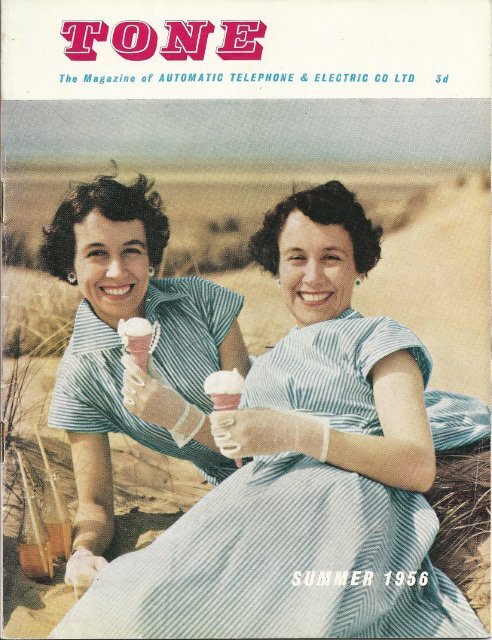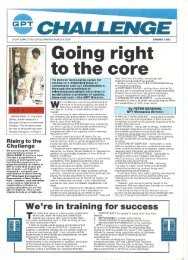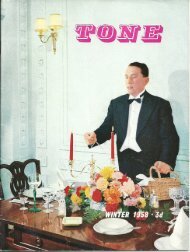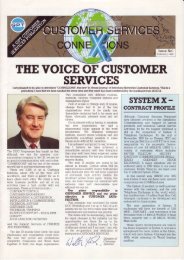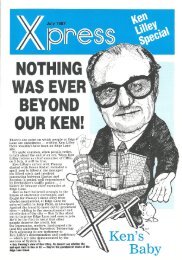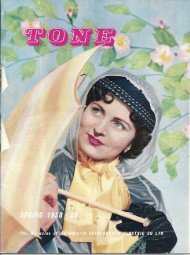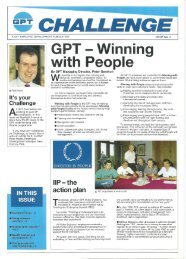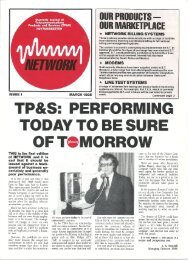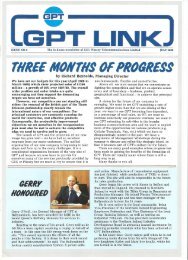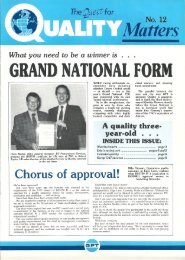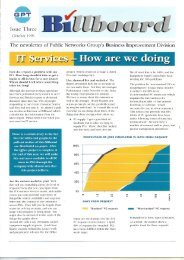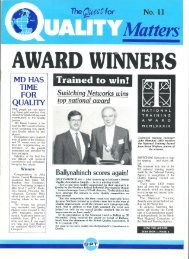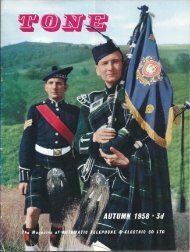ATE Tone Magazine - Summer 1956 - Edge Lane
ATE Tone Magazine - Summer 1956 - Edge Lane
ATE Tone Magazine - Summer 1956 - Edge Lane
Create successful ePaper yourself
Turn your PDF publications into a flip-book with our unique Google optimized e-Paper software.
@<br />
.r-, r*
AUTOMATIC<br />
@@ryE<br />
THE QUARTERLY MAGAZINE OF<br />
CO. LTD.<br />
ISSUE NUMBER THREE . SUIYMER <strong>1956</strong><br />
Contents<br />
Introducing India ... ... This page<br />
Heroes in black and white 4<br />
Busy lines 6<br />
Diamonds in the dust ... ... ... 8<br />
A reputation built ... l0<br />
^<br />
lVe'd lihe yu lo meet ... ... ... 12<br />
Men behind your merurs ... 14<br />
Columbushould see it now ... ... 16<br />
Portraits of an industrjt ... ... lB<br />
Hot... ...20<br />
. - and cold ,,, 22<br />
Cooer lwins cloch up 20 lears --- ... 24<br />
GoId, scorpions and blach magic ... 25<br />
Men with wheels ... 26<br />
Stroztger worhs wonders<br />
Inside back cooer<br />
Eilitoidl comwiltee :<br />
C. E. BEALEJ G' BENNBTTJ G' D' CHRISTIEI<br />
R. A. KEIR, A, J. MUSKETT, W. S. VICR<br />
Ed,itor: w, I w ALI,S<br />
All communications :<br />
EDITORTAL SECTIONI PUEI-ICITY DEPARTMENT'<br />
sT, vrNcENT SIREBTJ I-MRPOOL 3<br />
TELEPHoNE : RoYAL 8884<br />
$ntrobc.c,,ng<br />
TNDTA<br />
ftttl<br />
(,
One af the shaL! places of lltdia,'l<br />
he Birla TeltAle, \leu Delhi<br />
Ffo n ..r. rn.rll Lrirr.ir, fJ' l r ro h<br />
lndian Telephonc Industries l,imitcd's moclcrn<br />
factory at Duravani Nagar, six miles lrom<br />
Bangalore, \\.hich no\r'cmploys more than 3,000<br />
pcople.<br />
I I la. I r]. \Lrnd ng urr d t70-ecre irc.<br />
conprises eighl unils covcring a tolai area of<br />
2,10,000 square fect, and dlere are, in rddition !o a<br />
$ree-storey admiristration building,.n ell-eqdpped<br />
laboratorics and rcselrch depar.mcnt, $'hich,<br />
togcthcr \rith a {igorous saics organisatron) conl<br />
biDc to makc the company one of the most up_!odate<br />
in rhe \ror]d. l']roduction is cxpaniling<br />
-rf dl) :.nJ pr. er .r \r , i- i r. or..<br />
30,000 autometic exchange lines and about 60,00r:)<br />
tclephone instrumcnts :nnually.<br />
Withill the next few yenrs it is expected rhat<br />
outpul wjll be sufticicnt to ncct rnost of India's<br />
own requirenenrs. Sornc idca of thc mtc of<br />
Indin's tclcphone expansion can be gaiDed from<br />
thc feci that since 19,17 rhc nunbcr of Lclcphones<br />
in usc drroughour dlc country has bccn nearly<br />
doubled and no\r'toials morc rhan 250,000.<br />
In addition to rhe host of complex compolents
ffi; ,"d^rr"l d"*t"pn' t is Lfura-modern Teleohone House' calcutta<br />
M^. l/tiaya Laksh"ni Pdndil' Hilh Canni eoaet<br />
'i", i,iii,1i"," rc rh'ee tndia" duritQ het<br />
"rtent "iden!'<br />
zti:it n Snousr Wnrks<br />
2<br />
-selectors) relays, automatic equipment €cks,<br />
telephones and dials-which go to make up a<br />
modern automatic telephone systemJ I.T.I.'S<br />
enginee$ have developed multi_channel carrier<br />
systems for which a new building, entirely devoted<br />
to the manufactlrre of the most up-to-date carflel<br />
transmission appararus, will be in production<br />
this year.<br />
Perhaps one of the most outstanding illustraiions<br />
of how Indian engineers have masteled the<br />
" know how " of telecommunications-the most<br />
complcx of all brancl'e' of elcctrical cngineeringis<br />
shown in the progress made in the bold schene<br />
to provide Calcufta with an automatic tclephone<br />
service second to none. The schemc, basecl on<br />
the Direcror system first developed by A.T. & E'<br />
for the British Post Omce to seNe London, laid<br />
down a fivc stage programme lor lhe conversion<br />
from manual to automatic working<br />
The first stage-completed in lg53-involved<br />
the conversion of some 13,000 lines, and was<br />
carried out almost entirely by A.T. & E. The<br />
second slage-6nished lasl year-"aw an increasirgly<br />
important part being played by equlpment<br />
made and installed by Indians. II1 the third,<br />
fbu$h and fiflh stagesJ 3ll the engineering work<br />
will be clone by I.T.I. at their Bangalore lactory'
SrtLbot of Lhe Reqltblic's histot;. pdst-the<br />
nrj Mahdl' Agrd<br />
'hcy will also supply thc flain s\iitching<br />
cqulprcnt<br />
and only a few itcns lvill bc manufactured<br />
y our company.<br />
A.T. & E.'s associatio with India bcgan many<br />
r.Lr, L'clore (l e (onclu'ion ol thc agrccmenl. in<br />
l4B, which lald the foundation for ihc hrst<br />
rdustry ro be established by her Government.<br />
arly automatic telephone equipment installed in<br />
rdia was of the Strowger type, which has been<br />
ioneered in Grcat Britain and ir, many othcr<br />
ountdes by A.T. & E. This form of srvitching<br />
, norv u:ed irr lvo lJrd. ul rhe \\'orld' 3-LomJri'<br />
xchanges.<br />
India's first automatic exchangc oi this type<br />
.as operating in Simla as early as 1914, only two<br />
ears alier the British Post Ofilcc had installed<br />
reir fiIst systcm.<br />
Students from India, as wc1l as studenrs ftom<br />
lany other parts of the worldJ can bc seen $orking<br />
c.ide.heir Bri.rs\ conprnronq dLring anv \ 'l<br />
) Strowger 'l(r'orks and this fact emphasiscs that,<br />
:om its inception, A.T. & E. has attempted to<br />
ass on the advantages of its lcsources nnd<br />
nowledgc so that they may benelit other countlrcs.<br />
lhe growth and prosperity of the Indian induslry<br />
just one ol many exanplcs shorving thc r.visdour<br />
f this policy.<br />
M'r. Pandit, uith Sir Thomas Eades, Vice-<br />
Chairlnan and Manas;rry Dlrectar, dnd ML J. A.<br />
Mason, Director an4 Mandger, at a P.A.X,<br />
derno]$ttation at <strong>Edge</strong> Ldne
t<br />
t-'ion attend an injned rider after crash at Lirerqool Speetlwav<br />
'r<br />
"<br />
Fleroes in black and white<br />
ST. JO}lN \IEN'S PROUD RECORD OF SERVICE<br />
Stock car racing at Stanley Speedway Stadium'<br />
Liverpool, was in tuIl swing' ff'" p'"tt"i<br />
""otJ<br />
Tblee of those men are stiil serving with the<br />
g:T!'"v: Mt<br />
^ {: Benn-ion' Department 94f is<br />
il,*"ii'.'^,.,,n - ..::h:t. ,,*y,:."*x;H: B;:IffljJ,p;1Tl:;,:.;,fi;3," *li]i"ffi<br />
around the track. Suddenly, one ot til'<br />
vehicles lurched crazily and ptott,n"a ft""a-o" the rank of Divisional Officer' and Mr' rW' E'<br />
;#; ;;;;; rr.*i"' a v*r'g mv ai'a Jones' comrnissionaire' is sergeant All three<br />
"oa<br />
sevesl other spectaton wele Withi" have been awarded long-service nedals with two<br />
"'l"t"o<br />
:::ffi. ;; ;:*a, *"-t'"" ot A'T l'l' oi"i";o" clasps' and Mr' Bennion Mr' Pa'. are serving<br />
'nd<br />
.i,r" ii. i"h" Ambulance Brigade werc on the Brothers of the Order'<br />
he Ambulance Division has 36 members'<br />
spot gil,ing fi$t ald.<br />
Th*t was only one occaslon, bowever' when the whose iobs *:t" fl,:i-,1*hi"" operalors' cletks<br />
men in biack-ancl_rvhite \tele on f'"oi-i" thtir and foremen' to rack wirers and tool setters' while<br />
sDare time and at thefu own expense-ro bri[g help the Nu$ing Division' undet their present Supernto<br />
others. Vherever there's a tttdtot' Miss D B' Ambrose' General Ofice' has<br />
"'o*a_itt"it't "<br />
St. John mao or ll'oman' Vo"ff fi"a tii* 14 members Miss E' Miller' Pe15onnel and<br />
"t<br />
cricket matches, in rheatres, ,no..r_-".Jrr*, velfarc, .trho 25 years' service with the st'<br />
", -has<br />
racecoulsesJ foadside boxesJ .""-"" ;; ;r;;; John, rerired from- the- post of supeintendeff of<br />
important, at any time tft" o"itu''oo'i"" ihe N']rsing Division last year' Drill nights arc<br />
at home, in ofnce or w"'L' 'luling N"t'-"'pl"r'li"'i' *" *<br />
the works' canteen and<br />
:1":*:::,<br />
their presence more desiratrte ttran rn rr,lustry. every member must put in at reast 12 sessior$ and<br />
That is why, 2? vears aro, u t'otttt'" otii"itiittt- 11 p;blic duties each vear' Thev all take arnual<br />
i'a o:^<br />
'pi'i*i -"n' *" t" t:.l-:il:li"'rT; '" ffiTflli1li.t." who are attached to<br />
-embers,<br />
:il""::il#:":i*T;ff:"":ff:i:iJiH;;; ; r,11 ;;;'11.,, '-i".* si'AB ',',"' p"ood 'lo<br />
have been present-on three Royal visits to Mersey-<br />
side-in three difierent reigns' They were on duty<br />
when Kiflg George V €nd Queen Mary opened<br />
the Queensway Tunncl in 1934' when the late<br />
Vorks and decideal to form a local divisioo of ;e<br />
of the oldest orde$ of chivalry t" to" *otii-iit<br />
Venerable Order of the Hospital clr Si "'iclf'"- tlf<br />
Jerusalem.<br />
4
King and his Queer visited Strowger Works in<br />
1942, and again when the present Queen visited<br />
Liverpool School of Trcpical Medicine in 1954,<br />
Among rhe Division members who have dis<br />
played individual gallantry in the service of oihers<br />
are Mr. \V. Shiclds, one of our gatekeepers, and<br />
Mr. George Parr, who we mentioned earlier.<br />
Mr. Sl-rields crawled under a'bus to aid a tmppcd<br />
man and Mr. Parr was an'arded the Meritorious<br />
Service Certificate-the only olle in Liverpool<br />
for goiig to the rescue of t$'o swimmers who r,!'ere<br />
b€ing battered by violeot waves.<br />
The Division is equally proud of its lorg war<br />
service. Members met and worked in dozens of<br />
hospital trains on Merseyside and escorted<br />
wounded soldiers and civilians to and from cities<br />
thrcughout England, \X/ales and Scotland. Even to<br />
the prescnt day, St. John members all belong to<br />
the Civil Defence.<br />
Dudng working hours, the division guarantee<br />
to have men on the scene of any incident within<br />
one minute of receipt of the eme.gency telephonc<br />
cail " 00 " and members repor! for duly with<br />
thc $'orLs fire brigade. The management makc<br />
ln a[null grant !o thc division-as unilorms cost<br />
as much as d16, but fust aid equipme[t is paid<br />
tbr from their own pockers and certain othcr<br />
considerations are also given,<br />
Mr. J. A. Mason, Director and Manager, is<br />
honorary president of " D " Corps, No. 5 Area,<br />
while Mr. nF. S. Vick, Deputy Manager, Works<br />
Control, is honorary presidcnt of A.T.M. Division<br />
and a Selving Brother of the Order. Among th€<br />
Vice Presidents of A.T.M. Division are Mr. G. D.<br />
Chdsrie, Company Secretary, Mr. C. H. Evans<br />
Personnel and Welfare Manager, and Mr. A<br />
McNeill, Labour and lielfare Superintendent.<br />
Mr. T. H. McCracken, of the Transmtssro<br />
Division, is also one of the long serving divisiona<br />
oficers. The divisional medical omcer is Dr. A. N<br />
Coondoo, of Childwall. Dr. T. E, Lloyd, th(<br />
Company's senior medical officer, is " D " Cory!<br />
surgeon, and Dr. J. K. McCann is surgeon t(<br />
A.T.\4. Nur:rng Dirision. "D Corn..uperin<br />
tendenL is Mr. J. Lunt, a SeNing Brother, and th(<br />
Corps secretary is Nlr. J. Boyne, lbreman o<br />
Department 56.<br />
Thc St. John Anbuiance Brigade in Englanc<br />
and Wales alone comprises Inore tl-nn 71,00<br />
men and women. Their emblem, the white, eight<br />
pointed cross, was first unfurled in about 1291<br />
and never has it floq'n more proudly than today<br />
The body armour worn b-1, the Knights of St. Johr<br />
disappcarcd after the Hol_\' Vars, but the spiritua<br />
armour remains unternished and the moderr<br />
knights staunchly maintain a t.Adition of scll<br />
appointed service that has survivcd for cigll<br />
. ,:.:,.:<br />
.'..'.r, r,',,.,<br />
n<br />
:<br />
,&;,.:<br />
A reali*ic exetcise in the<br />
<strong>Edge</strong> La e<br />
Works Canteen at Tuo N.C.O.'S of A.T,M. Ditiion tend
Busr<br />
w<br />
I1l/E S<br />
ln the first 17 hours of the G.p.O.,s new<br />
l0-second summary ueaLher-[oreca-ring<br />
servrce (speciat equiprnent by A.T. & E.)<br />
more than 55,000 calls were received lrom<br />
the present radius of 20 milcs from Channg<br />
Cross.<br />
Dufban (South Africa) authofties hare<br />
placcti an order uith A.T. 6, E. for th€<br />
ixecessary equlpl ent to install z)ehile-actudted<br />
trafrc siEndk at 26 oJ the cit),s intenecuons.<br />
The signak forn ?art of a maior ttaffu. re_<br />
organisatiofi plan.<br />
At home, a novel installation linking<br />
trafic signals rvith rhe mechanism controllilg<br />
railway levcl crossing gatesJ which<br />
cu'acro,- Lincoln's High Srrcet, \\ent inlo<br />
operation recently.<br />
Pdtt,rl thc.W/eather<br />
.<br />
equippt'n beiry inV..ted<br />
acrofe reqvtng rhe Jatrary<br />
Won against stroxg foreign camtetitiun, a<br />
.ontract to sup?U equipment for the frrst<br />
coaxial cable telecomnunicatiolts ststem ever<br />
installEd in Neu Zealand, has been placed b))<br />
the N.Z. Posts and Tetegraphs Department<br />
zLtith A,T. €c E.<br />
The firsr-ever system of progressively<br />
iinled craftc .ignals ar pedeslrian crossing,<br />
A.T. & l. equipmenl . is now in operation<br />
as part of one of the nation,s largest safety<br />
expenments at Siough (Bucks.).<br />
An order to supply singte-channet V,H.F.<br />
fadio l;nhs to register consumer demanil and<br />
control had-shedding berueen the head_<br />
quattcrc oI one ot Ne.t Zeatond.r najor<br />
,lett.icitv supplr boa,^ otd th,,c ,ub-station"<br />
has been placed \ith A.T. tt E. (N.2.) Ltd.<br />
Television personality Katie Boyle made<br />
the first call using p.A.B,X.<br />
cquipment<br />
6<br />
A ztieu of Slough's busy High Stteet now serted<br />
bj A.T. €t E, s;gnals eq*ipnent
nanufactured by this Company for<br />
Associated Rediffusion Lrd., I.T.A. contracrors<br />
for the London area. Stage. screen.<br />
I3dio and T.V. star, Ben Lyon) received the<br />
fiIst call.<br />
Here's a breath of salt air-Compaq)<br />
equipment is in the neu d5,000,000 Cunard<br />
Iiupr " Cainthrc. rhe ne. Canalian Pa:i"6c<br />
Ii er " Entress of Britain," the eu Rayal<br />
Nauy wssel " Cumberlafid," tuo neu thips<br />
o.[ the C hilean naq] , dnd sh;?buiden, HarlanC<br />
& Wolf, haw recentb, acqubed one of our<br />
P.A.X.'s.<br />
San_ple. of our cquipment relpphone..<br />
relays, etc,-were sent out from Livcrpool<br />
rccenrly for rhe atlenrjon of the Russian<br />
trade delegation {,hich visited this country.<br />
Teletision personality Katie Bolle sees o!!r nev)<br />
P.A.B,X. installation<br />
Canadian Embassy olrtciak tu Takio were<br />
delEhted airh the rush order, completed dt<br />
Strowger lYarks, fot a P.M.B.X. under<br />
Di?landtic Wieless Settice arrangemenrs.<br />
The eryipnent w*ent aut to Jd?dn b! ai.<br />
In an efort to add to the speed and<br />
':<br />
t<br />
Freetown Docks, gatewqt to Sieftd Leone and the rich diamand country<br />
Diamonds in the dust<br />
RADIO AIDS SECURITY IN SIERRA LEOh-E<br />
The bare-footed Alricar in dust-coverect shirt arld<br />
tattered shots walked uncertainly across ro a<br />
clerk seated at the counter of the trading centre.<br />
From beneath his shiri he pulled a bundle of otd<br />
cloth. Slo*4y he un\'ound the cloth and a large<br />
" rcck " clinked upon the counter. There was<br />
nothing particularly glamorous about the rcugh<br />
chunk of stoneJ but when the native leli a shorr<br />
time later, he had a smile from ear to ear, and was<br />
richer to the tune of d20,000 paid in cash.<br />
Now beforc you leave your benches and desks<br />
in search of " rocks " rhat will make your fortune,<br />
perhaps we shouldexplainthat althoughthe incident<br />
desc bed is fact, it happened in far-of Sierra<br />
Leone, the British West Afiica protectorare, and<br />
the lock in question was a very large uncut<br />
diamord.<br />
The man who can vouch fol the authenticity<br />
of this story is Mr. Rex Fen€more) a member of<br />
the Systems Plarning Depertment of A.T. & E.<br />
(Bridgno{h) Ltd., who rccently returned to this<br />
country .fter supen'ising the installation of a<br />
{t<br />
|adio system for the Diamond Corporation (Sierre<br />
Leone) Ltd-, a subsidiary of rie Diamond Corporation<br />
Ltd. of London. The Corporation have two<br />
main tading centres in Sierra Leone, Iying some<br />
170 Iniles north of Fleetown, thc capital. It is to<br />
these centres that the native prospecto$ bring<br />
uncut diamonds for sale.<br />
The stones are *'ashed down lrom rhe<br />
surrounding hills by rain-swollen ri\'ers during<br />
the wet season, and the natives prise them from<br />
rhe rivcr beds with little diliculty. The job calls<br />
for patience mthea than skillJ and normally the<br />
finds brought in do nor amount to anything like<br />
the {20J000 quoted. A ferv hundred pounds is<br />
nearer the average.<br />
There i. also anorher snag Lhar .hould be<br />
mentioned. In Sierra Leoner prospectors' licences<br />
are needed before _'\rou can enter the diamond<br />
busiress and thcy are issued only to natives. If<br />
you are on the right side of this colour-bar-inreverse,<br />
you cdn obrain a diggcrs' Iicence lor d),<br />
and for d25, set yoursell up as a dealer.
The tradi[g posts have been established in an<br />
effort to discourage illegal tralAcking in stones, and<br />
the radio equipDent installed by A.T. & E. is now<br />
playing a vital part in their day to day opemtion.<br />
Bo, a Iargely rative community, is cut olf from<br />
Kenema by a mrge of hills dsing to about 1,000<br />
feet and, although the direct route bctwcen the<br />
two points is only about 38 miles, the journey by<br />
the twisting mud road is nearly t\r'ice that distance.<br />
Mr. Fenemore's task was to install a sinplex<br />
radio link between the two centres and also to 6t<br />
mobile equipment in t$'o ofthe Diamond Corporatiotr's<br />
Land Rove$. These vehicles are used to<br />
uansport uncut stones, otlen worth many<br />
thousands of pounds*fiom the trading centres to<br />
the airstrip near Bo, from wherc they are flown our<br />
ro lhe United Kingdon. Driver\ and rlreir c.cort.<br />
are now able to keep in constant touch with base<br />
afld this has greatly added to security.<br />
One of the many advantages of the ixed<br />
point-to-point link is that it enstres speedy<br />
exchange of information. It has been known in<br />
the past for a crafty prospector \l,ith a selection of<br />
stones to journey fiom one trading post to another<br />
-just to see if one would offer a highcr price.<br />
Now the radio link quickly teaches him thst his<br />
journcy is not reaily necessary I<br />
Technically, the installation is of interesr<br />
because it is the fimt mobile radio scheme employing<br />
the Conpany's new lo-\r'att Frequency<br />
Modulated RL equipment.<br />
For Rex Fenemoie, a maried man with two<br />
childlen, ir was his lirsi trip ovelseas on the<br />
Company's behalf. He lle\,v out to FreetownJ<br />
breaking his journey at the brighr{ighrs ports 01'<br />
Tangiers and Bathurst. Did he enjoy his seven<br />
week stay in a country where a " girl's best friend "<br />
is likely to be lbund hing ar the botton of any<br />
dried-up river bed? " It was most interestingr'!<br />
was his concise cornment.<br />
But when it comes to descdbing rhe Company's<br />
equipment, Fenemore is not so rericent. Full of<br />
praise for the way the mobile equipment has stood<br />
up to thc non-stop bouncing orl dusty Africar<br />
{oadsJ he says if it can stand up to these conditions<br />
it can survive anyrhing. A 150-ft. aerial<br />
mast now dominates the Bo centre, and Kenema is<br />
topped by a 70-ft. aray. These now stand as<br />
symbols of progress-and to the licensed natiscs,<br />
places where he can turn unatuactive lumps of<br />
stone into hard cash.<br />
One of the chief problems facirg a native who<br />
has " struck it dch " is what to do \,l:ith his wealth.<br />
There is not nuch to spend it on in thc mud-hut<br />
communitiesJ and the luxuries he craves are meagre<br />
to our standards. Despitc ofllcial encouragement,<br />
most natives are sceptical of banks, and prefer to<br />
carry large sums around with them. Thus there is<br />
always the temptation for the not-so-lucky prcspector<br />
to turn to violence and rheft-a problem of<br />
which the authorities are acutely aware.<br />
So, you see, even in a country where a fortune<br />
may be lying around iust asking to be picked up,<br />
cver!'thing that glitters isn't a diamond.<br />
The Dianord<br />
of Bo<br />
Corparatiort's premises at the toutl<br />
This is the equipment c-hi.h is aiding the diamatul<br />
oqyers<br />
9
The 19 I 4 War is over, orderc ro11 in,<br />
and A T 8t E Co adds to its growing history<br />
out Spring issue, ue described the beeinning anrl earli develo?ment (1884-19f4) of the mamfactniry<br />
.anhation ae know today as A tomatic Telephone E Ele.tric Compan:t Linbed. Manl older empl.q)ees<br />
re surprised at some oJ the little-known Jacts that &e presented and younger colleagues gained' perhaps' a<br />
per insight ituto the ind*ttry. In this edition, e attenpt to recapture some of the highlights of A T, E E.<br />
tory in the years that folhued. the frst uotld uar.<br />
rom telephores !o shell ftrses, submarine<br />
]tecto$ and other military orde$, to domestic<br />
)pliances, then back again to the business of<br />
Laking telephones. In bload oudine, that is how<br />
re wal allected Strowger Works. In the early<br />
ages ofthe conflict we abandoned the manufacrre<br />
of telephone equipment in favour of mun iI ion(.<br />
/ar-dme shortages later enabled the Company to<br />
rtroduce a number of fiesh ptoducts such as<br />
ectric irons, cookers, fires and vacuum cleaners.<br />
At the outset, these appliances, known under<br />
re geneml tmde narks of " Xcel " and<br />
Autopax " were designed and manufactured at<br />
trowger Works. Some idea of the quality ard<br />
rientific peifcction incorporated in their design<br />
ray be gathered from the fact that the No. I<br />
Xcel iron was, for many years, sold under a<br />
" life " guarantee, coveritrg free replacement at<br />
any time in the event of breakdown under fah use.<br />
Gradualiy a demand for these appliances was<br />
built up and the scope of Xcel products was<br />
extended to include heavy-duty equipment until<br />
incteased manufacturing space became necessary<br />
and additional factory plemises, known as Victor<br />
'Worl
facilitiesJ and was the ibmer headquarrers of the<br />
A.T.M. Sports and Social Organisation. But, we<br />
are jumping ahead slightly.<br />
Following the Armisticc in 1918, plant alld<br />
personnel at Strowger Works wete re-otga[ised<br />
on a peace basis and a fresh start was made on the<br />
manufhcture of Strcwger switches.<br />
Meanwhile, rhe United River Plare Telephone<br />
Company had satisfied jrsell that the Strcwger<br />
system was suirable for an expanding capital city<br />
like Buenos Aires and a vast Strowger network<br />
was planned h 1920 and actuaily started in 1922<br />
with plant manufactured by the Company and<br />
shipped from Liverpool. Today, Buenos Aircs<br />
boasts upwards of 604,000 telephones and we can<br />
take pdde in the fact that we laid the commumcations<br />
foundations for this great city.<br />
\n 1923, an earthquake and subsequent firestorm<br />
nvaged Tokio, third largest ciry in the<br />
world, and the Japanese telephone system was<br />
virtually destroy€d. A new nerwork for rhe<br />
devastated area had to be provided and ihe<br />
conttact came to us.<br />
About this time, tooj the British Post Oficc<br />
was faced with the maior problem of London, a<br />
telephone area of some 750 square milesj embracing<br />
-then*more than half a million subscribers and<br />
possessiflgJ moreover, an existing and costly cable<br />
network and a numbedng scheme which did not<br />
permit revolutionary changes. The Post OfEce<br />
decided that they would standardise on S6owget<br />
equipment fot London and their plovincial networks.<br />
It was hardly surprising, rhereforeJ following<br />
such a weighty vote of confidence, rhat orde$<br />
I-rom overseas began to flow into Liverpool in<br />
ever-increasing quanLities. Among importanr<br />
lerdtories that followed the lead of the B.P.O.<br />
werc Indiar Manchuria, Australia, Canada, South<br />
Africa, Rlodesia, Tanganyika and Iraq. And, in<br />
face of keen comperirionJ the fame ol'our main<br />
product also penetrated to the Continent, Poland<br />
and Lithuania were among the early customers<br />
seNed by equipment manufactured in Liverpool.<br />
Another ifltercsting flashback to this period<br />
concerns the boom in radio ftom 7922-27. The<br />
Company conftibuted its quota to the development<br />
of receiving sets and rnany thousands of<br />
world-famous " Claritone " headphooes and loudspeakers<br />
were manufactured at Strowger Works.<br />
In fact, a comprehensive record of the commercial<br />
achievements and developments caffied out<br />
A Strowger lVorks fashbackwiring<br />
as it used to be<br />
by A.T.M. following the First Vorld \i[ar up ro:.he<br />
early l9l0 s \ ould almosr fill a volume on its own.<br />
Two of rhe more striking adaptations of the<br />
Strowger s$itching principle, however, desetve<br />
mentiofl. They coarcern tacecoursc totalisators<br />
The fust All-Elecrric Totalisator, designed,<br />
engineercd, manufactured and installed by our<br />
employees, was seen at Newmarket in 1930<br />
and proved an immediate success, King George V<br />
and Queen Mary inspeded our eqr pmenr at<br />
Ncwmarket and visited our installation at Royal<br />
Ascot the follcwing year.<br />
The Company were also tesponsible, a year or<br />
two later, for EVA, a very " efiicient lady " who<br />
has helped to solve London's (and thq nation,s)<br />
lramc problems, Eva uas Lhe name given to<br />
Electromatic Vehicle-Actuated street tmfic contlol<br />
signals, and A.T. & E. were +e first to install<br />
them in Europe-at Comhill, London, in 1932.<br />
Electromatic tralnc signals are now such a cornmon<br />
sight in every busy thoroughfare, at home and<br />
abrcad, that a description of their usefulness is<br />
superfluous.<br />
The odginal (1912) title of the Company,<br />
Automatic Teiephone Manufacturing Co Ltd<br />
rras eventually changed to Automatic Electric<br />
Co Ltd) representing a less rcstricted spherc of<br />
activity, and in 1935, the organisation became<br />
Automatic Telephone & Electric Co LtdJ as it<br />
is today.<br />
lTo<br />
be continued
During their lunch-hour, Mrs. May Devlin and<br />
Miss Joyce Giles, two girls from our Stopgate<br />
<strong>Lane</strong> branch factory, help to look after the attlact2<br />
rr7 a t t.t<br />
|| (' JI ItEl'<br />
aata<br />
to tnetot...<br />
Mariot!<br />
Frear, balbootn dancer and motorqtclist<br />
A maintenance itter at Strowger IVo*s, Mr. H.<br />
WilsoD, Department 46, is a collector of antique<br />
door-knockers. He has one specimen, known as a<br />
" flaming lion," \rhich is about 200 years old. It<br />
came from the old mansion house at " Vrhitfield."<br />
Joe Flaherty, a setter in Department 02, Strowger<br />
'WorksJ who went to sea at 15. Torpedoed three<br />
times during the war, he sailed in " Hecla," a ship<br />
mentioned in the novel " The Cruel Sea." Sparetime<br />
pu$uir ? Leader of an eight-piece dance<br />
band.<br />
Mariory Frear, a typist in Purchasing Department,<br />
is one of the most promising amateur ballroom<br />
competitron dancers on Merseyside, with<br />
many awards to her credit. She is also a very<br />
competent motor-ryclist.*<br />
Twenty-year-old Kathleen Edgleg Publicity<br />
Department, City Factory, won the challenge<br />
trophy for grand opera at a recent Liverpool<br />
Music Festival and-in the same event-the<br />
oratorio solo challenge cup.<br />
The model crane built by tuo of on<br />
emplovees<br />
Co-builders of what they believe to be the only<br />
mdio-controlled model crane in this area are<br />
Mr. A. Bell (inspectiotr foreman, Telegraph<br />
Division) and Mr. A. Gtedhill, Depanment ?12.<br />
Construction took more than six molths.
tive ornamental surrrmer garden built by orher<br />
employees from a strip oi waste Iand at the back<br />
of their factory.<br />
Mr. Gls Russell, Department 15, Strowger<br />
rvorks, a kecn racing tricyclistJ ofren acts as<br />
" pathfinder " on Sunday runs for a registered<br />
blind man who also tdes a three-wheelcr.<br />
Tur tanJ'c?p. ga.detet. ., \t.t-9"r. I -'.<br />
Eighteen-year-old Carol Carter, typist in the<br />
manager and chief engineer's ofice at City<br />
Facrorv. ha" e.rdbli\hed a rcpularion a., sprinrer<br />
and is a possible choice for the British team at thc<br />
Melbourne Olympic Gamcs.<br />
Main switchboald operator at Srrowger Works<br />
lbr rnorc Lhan 20 years, Mrs. E. Bames has<br />
handled many hundreds of thousands of calls on<br />
behalf of A.T. & E. Shc is quite accustomed to<br />
telephoning North America, BrazilJ India, Ausrralia<br />
and the Cofltinent.<br />
Mr. W. Kendrick, Planning, Deparrment 97,<br />
has been collecting stamps for more than 20 ycars<br />
and cstimatcs that he now owns somcthing likc<br />
40,000.<br />
Former policcnan, plrblicaD and cinerna manager)<br />
Mr. G. Birch, Tlaffrc, Department 03, has also<br />
been a professional vadety arristc and has had<br />
cngagcmcnts at thc London Palladium and big<br />
New York theatres,<br />
Mrs. E. Barnes, the s titchboard operatar<br />
Warrant Commissionairc Arthur Brookes,<br />
Milton Road entrance, a formcr Chief Petty<br />
OfEcer recruitcr for the Royal Navy, has visitcd<br />
alnost every porr in thc world and toured evcry<br />
village and hamlet from Abcrdovey to Barrowj<br />
enrolling men for the Scnior Scrvice.<br />
Mr- Cyril Bell, Contrac$ Dcpartment) (lity<br />
Factory, is sparc time organist at Si. Paul's<br />
Church, Wallasey, and has played " Here Comes<br />
the Bride " at more than a thousand weddings in<br />
lris 31 years as a self-taught mxsician.<br />
Energetic sccretar,v of rhe Sports and Social<br />
Organisation, ]!Ir. A. J. Muskett, recently celebrated<br />
his 80th bilthday.<br />
Cotnnissiottdire Bnokes uih bixer Harrg Hohnes<br />
Hatte YOU an interestirtg or uilusudl petsofidl<br />
story to tell ? If so, we'd certoinly lihe to meetlou !<br />
1l
Men behind<br />
Canteen meals<br />
Mr. C. K. Jennilxgs, staff cantaen manager, and<br />
his head.hef, Mr. V. Br.tnthuaiti<br />
Staff canteen menus arc totalled. and checked b5t<br />
tuto of Mr. Jermings' assisunts<br />
t4<br />
The man with a passiotr t_or t'asr motor bikes<br />
nibbled a thin slice of bread aad butter reflectively.<br />
" No," he mused, " I doa't reaily<br />
think that I can claim to be a big<br />
Not a sranLiug staremeei, realli_ -arer." bui inreresling<br />
when you re8ecL tb-al rhe !o2n i! qu$tion,<br />
Mr. C. K. Jelniogs, stafi canieen nrn,ger at<br />
'Works,<br />
Strowger<br />
helps, in a big $at, together<br />
with his colleague in tle sorts ca.ateea, Mr. I.<br />
Hughes, to keep lhe \rheels oi iBdustr,r tu:rnhg by<br />
providing r-be rrgbr kind of tirad rbr-1ar.<br />
After jokes about morhe:s-h-1aF, rhe favoudte<br />
butt for gene€tions ol comediaas has been canteen<br />
meals-always good for a r@r of laugbter and a<br />
round of applause. But etre! geinirg an insight<br />
iinto the orgaaisaiiod of the cEte€Ds ru! by<br />
Mr. Hughes and i!lr. JeDnin€s, 1Fe Bre aot at all<br />
sure that there's anything to leugi aL For the<br />
preparrtion of food, to tllc-.c t\iro EeD. is a very<br />
sedous business.<br />
Think for a momert abour tie scope of the<br />
project. Feeding the offce asd factor-v workers<br />
at <strong>Edge</strong> <strong>Lane</strong> is equivalent to feediDg tle popuiation<br />
of a fair-sized to\l.d. And piclure tbe bebind-tlescenes<br />
wod
' aour n}enur,s<br />
tre no joke to th.em<br />
l I<br />
i<br />
J<br />
conlse, diners have distinct preferences for certain<br />
dishes. For instance, two out of three employees<br />
will plump for egg and chips before ordedng more<br />
imaginative and elaborate preparations.<br />
Mr. Jennings was formerly a chei at the Government<br />
Hospitality Hotel, just off London's exclusive<br />
Park <strong>Lane</strong>, and he frequently cooked<br />
meals lor the President ofthe United States' when,<br />
as General Bisenhower, he used to visit the capital.<br />
Mr. Hughes is a smiling, effcient and very capable<br />
Velshman lrho has a staff of 53 people under his<br />
control.<br />
In the works canteenr the self-seffice method<br />
is in operation al1d diners choose " on the spot "<br />
instead of making prior decisions. Each dayJ two<br />
confectioners make no fewer than 3,000 chocolate<br />
eclairs, shortbreads) apple tarts, stlawbcry tarts<br />
and sausage rolls, all of l.v'hich sell like-well,<br />
hot cakes.<br />
In general, canteen menus are suggested by the<br />
catering managers to meetings of their respective<br />
canteen conmittees. Each committee is self_<br />
contained and comprises dinels who are elected<br />
by ballot and representatives of the Pe$onnel and<br />
\{relfare Department. Membem consider coln<br />
plaints and suggestions and decide on advance<br />
Now, we've given you a brief idea of the story<br />
of food inside the facloryJ but what about a side-<br />
Iight or Mr. Jennings ard Mr. Hughcs ottrrae<br />
the factory ? As we've mentioned, Mr. Jennings<br />
is a motor-cycling enthusiast, while Mr. Hughes<br />
is a keen motorist, You might thiDa these outdoor<br />
pursuits would put an edge on their appetites but<br />
not a bit of it. IIl their own homes, they like to<br />
forget about food as much as possible. Mr. Hughcs<br />
is an exrremcly light eater. while Mr. Jennings<br />
the man who cooked meals for lke accepts without<br />
comment whatevcr his wife places before him.<br />
Both agrce firnrly that a woman's place is in the<br />
kitchen.<br />
Mr. I. Hughes, uorhs canteen manager, uith one<br />
o.f his chefs, Mr. C. J. Fldtaz<br />
A ?opular innota?ion in the uorks canteen is the<br />
urck shof, alwats uell patro sed
ffieS'.:<br />
ryt.rre4&<br />
One of the many fine motorways, knoun as autospitzas, sening booming Venezuela<br />
Columbus should see it now t<br />
I.'ene
In 1946 a 7,000-line exchange, made and assembled<br />
at Strowger rJTorks, was installed at Los Caobos<br />
but, as the city's prospedty increasedr two furrher<br />
extensions of 3,000 and 5,000 lines became<br />
necessary and these also $.ete shipped out from<br />
Liverpool. Toll routes insralled berween \ridely<br />
separated cirjes kepr the Company's cngineer,<br />
*,<br />
-<br />
l.q{"*<br />
Mr. W. Howarth, of the Telephone Systems<br />
Planning Group) Strowger\vorks, constantly on<br />
the move. Mr. F. J. R. Boote, the installer with the<br />
longest service in Venezuela, is due to retun to<br />
England on leave this year. Other A.T. & E.<br />
(Liverpooi) employees who are familiar with the<br />
Venezuela scene are: Messrs, S. C. Morley,<br />
F. Seery, M. G. Casey and J. D. McDonald<br />
(Installatior Department) and J. Riding (Deparrment<br />
35).<br />
Another A.T. & E. employeeJ u,.ho has Mr Donohue aith his Pontiac<br />
recently returned to this countty from Venezuela<br />
after nearly three years' service<br />
and the landslid€-said to be one of the worsr<br />
is Mr. E. J.<br />
Donohue,<br />
ever to occur in Ve[ezuela-completely<br />
Systems Planning, Str:owger<br />
blocked<br />
House,<br />
London. Mr. Donohue was plant the n i\ autospitza. The cabling for<br />
superintendentj<br />
our valuabk<br />
engineer-in-charge of thc l\{aracaibo<br />
equipment was bu:ried at one point beneath<br />
telephone<br />
tons<br />
arca. Maracaibo is the maior rown in the<br />
of rubbleJ but was found to be only slightl)<br />
weaithy<br />
oil province of Zulia.<br />
fractEred when Mr. Jeflkins examined it after thr<br />
On his way back to England. via thc Unired<br />
road was re-opened some t\\''o months later,<br />
States, Mr. Donohue became a car-felry<br />
South American engineers are continuall]<br />
driver.<br />
He<br />
planning<br />
agreed ao take sn American Pontiac<br />
new way.<br />
from<br />
ol e\rending (elccommunica<br />
Miami, Florida, to Chicago, Illinoisj a djstancc<br />
tions to span some of the most desolate anc<br />
of some 2)200 miles through six diferent<br />
isolaled rcrrrin in thc world, and rhe equipmenr<br />
states.<br />
Apparcndy, wealthy Arnedcans are in the<br />
\rhich we in Liverpool are producing,<br />
habit<br />
will he11<br />
of driving to Florida, spending a vacation rhere,<br />
them in their colossal task.<br />
retuming by air and engaging car-ferry specialists<br />
to have their vehicles rerumed to them. Car<br />
expenses for Mr. Dolohue and his wife, Sheelagh,<br />
a Liverpool girl, were paid by the feffy-specialists.<br />
A member of the Tmnsmission Division staf<br />
of Strowger \J{rorks) Mr. Noman W. Jenkins, is<br />
now back at <strong>Edge</strong> <strong>Lane</strong>, after helping to instalt<br />
200 voice-frequency repeatcrsJ built in Liverpool,<br />
for a telecommunications network betwcen Caracas<br />
and Maquietia, some 16 miles distant.<br />
It was a visit ol " firsts " for Mr. Jentins. . .<br />
first trip abroad for the Company. . . first time he<br />
saw a bull-fight . . . and fiIst time he saw the eflects<br />
of a landslide, \Fhereby hangs a tale.<br />
The weather was wild as South American<br />
workmen Iaid an underground cable, containing<br />
2lo pairs of relephone wires, in rhe mounrainou.<br />
country that stretches from Ca€cas to Maquietia.<br />
Just before Chdstmas, pouring trcpical rain arld<br />
violent wind\ whipping acrocs rhe mounrains Struct*al engineeriry on some of the most desolate<br />
loosened millions of tons of loose scree and rubble, teftain in South America
Number lwo in a series<br />
Portraits of<br />
an Industrv<br />
In a large organisation, uith a<br />
host of dffirent deftartments, it rs<br />
o.ften dfficult t0 appreciate, 0r eaen<br />
aisuali.re, the cantributions made<br />
t0 the industrJ b3t emplolees outside<br />
one's own ffice or uorkshop.<br />
In this second series of special<br />
pictures, we introduce to yu a Jeu<br />
more rl the typial .iobs tackkd<br />
b2 A.T. A E. personnel at Strowgur<br />
I,[/arks and associated branch<br />
.f actories. We hape the operatians<br />
and tasks depicted uiLI giue yu<br />
a better insight into the zuide rongc<br />
o.f skilk, techniques and technical<br />
know-hout at the command oJ lour<br />
colleagues in the telecommunications<br />
/ield. Furtlter representatiae<br />
phatographs ruill be presented in<br />
our next i,;sue.<br />
One af the tashs ;n Depaftne t 89-the testing of<br />
uniselectaf s far autotnatic,Elephone eqlipment<br />
One of the telephorc assat;bly proczxes- A ehl front<br />
Department 26 pla.es a dial in a telephone case<br />
l8
X<br />
t,:<br />
A \1p"tl,cr ol I<br />
'p<br />
rtt.t't DcpJ,rry,,, fran.ryi*ry<br />
tt:tP't5 lor bcat' zthtL 1c"1t4g rc,rte, ,!t"ipn.' .<br />
A t pha,p .1.<br />
ha..be.u a-. u,brca aLd th.. cnptaye.<br />
corflc\ out an tntportant acoustiL rerr<br />
In Departrnent 31, a operator at a nachine uhich<br />
hlanhs out relay springs from a long str;p of metat<br />
A,t cnpl ',.,. o. t.tnept Worh.. tVryar, t ires a tesr<br />
.et- stnutai ope,orta4s at. donp at Fdge Lan.
1.,.-:.<br />
,'..:,<br />
t<br />
Hot...<br />
Mr.<br />
N. G, Rejnolds<br />
Nosr cnaHalr nsyllol-Ds ar?d RoN scorr<br />
are bot]t commercial elgineers.<br />
They occupj)<br />
neighbowillg deshs in De?attme t 892 at<br />
Strouger Wo*s,<br />
but their uork on behalf o;f the<br />
lifm could not haxte tdken then Jurther apart.<br />
Mr. Reynnldr let out ,ecenrt) to a sun<br />
drenched ldnd in the Middle East anct Mr.<br />
Jour ejed. to a blizzard-szrept teftitor)) in<br />
the frozen North West. These are their<br />
impessions of the countries thq ois;ted.<br />
Mr. Reynolds joined A.T. & E. ift 1g3a<br />
in the Inspecrion De2artment and has beer,<br />
Scott<br />
ln commercial engineeriry for the pdst ten<br />
years, A md1-rie.l man, liz;ing in Watertao,<br />
Ltuerpool, h;s nain r ecreations are sketchilq<br />
and pa;nti?L?. Mr. Scott, also marr;ed,<br />
with one son, ltues in lVauertree. He joineA<br />
Department 12 (Loading Coils) in 1935.<br />
i.,<br />
It was one hundred and ten degrees in the shade*<br />
if you were lucky enough to find any shade. I<br />
could aimost see thc heat as our airiiner taxied<br />
ro a halr on Cairo , shimmering. modern airpon.<br />
As the aircralt doors swung open, I experienced<br />
my first taste of the heavy, breathless atmospheie<br />
of the Middle East,<br />
Cairo, I discovered, with a cosmopolitan<br />
population of more rhan 2,100,000, is a city of<br />
never-eqding contrasts. Camels use the same<br />
roads as CadillacsJ tumble-down hovels lie cheek<br />
by jowl with tall hotels, and leisurely native bazaam<br />
nestle in the same block as slicl< bargain basements,<br />
Even the timeless waters of the Nile are harnessed<br />
to help modern agdculture and industry.<br />
Ncgotiations ovet communications within<br />
Egypt's 3861000 square miles enabled me to spend<br />
more than three morths in CairoJ Ismailia and<br />
Z^g^zik, My working days started at 8.30 a.m.,<br />
but after lunch, all toil ceased until after 5 p.rn.<br />
Afternoons were spent at an open-air swimming<br />
pool sipping iced ddnks. On free days and late<br />
evenings after work, I ivent sight-seeing. Cairo<br />
at night is a rxther gay, neotr-lighted Middle East<br />
version of Manhattan and, viewed from the air, it<br />
is quite spectacula..<br />
Ifl ofle of the popular open-air cinemas, I saw<br />
" The Desert Song "*English sound uack with<br />
French and Arabic sub-titles-but I found the<br />
Holl].wood version mote romantic than the real<br />
thing. Film aflor\. unlikc commercial engineers.<br />
don't seento be bothered by the heat and powerful<br />
Mr. R. Scota<br />
20<br />
x ".<br />
:.:':<br />
l::'<br />
Like thousands of other visitors to E$pt, I<br />
ioumeyed a few miles out of Cairo to see rhe<br />
Pyramids of Giza and marvel at the ingenuity of<br />
their architects. For a srnall fee, the hor uaveller<br />
can sit afld watch native boys grow even hotter<br />
as they climb to the top of the Great Pyramid, all<br />
451 feei of it, and back in abour ren minures.<br />
Nearby, the Great Sphinx, with inscrutable smile,<br />
stares across the dese{ and the centuries.<br />
I also went to see ofle of ex-King Fatouk's river
The Mohamed A/9 Mosqle dt the Citddet, bath.d. in stifie*ls<br />
,utt:hine<br />
boats, nolv used as a nighr club for tourists, and I<br />
recalied rhat telephone equipment for the cxking's<br />
privare yacht had been asscmbled ar one<br />
of our factodes in Liverpool.<br />
Perhaps my most vivid memory of Egypt also<br />
concerns Farcuk. !7e had been exploring deserted<br />
country neat the road to Ismailia when our pary<br />
stumbled across r,vhat had once been a luxurious<br />
country vilia, now crunbling and sinking under<br />
the desert. An old ma1l shuflled our of the ruins<br />
and explaiocd that he was the caretaker.<br />
" The villa is in need of much repair,', he said<br />
ruefuily, " but I arn waiting fot my master: to<br />
ir Who i: your<br />
.. ma\rer.. we a.t(ed him.<br />
" His Majesty," was the reply.<br />
\Ve looked at the dry and brokeD swimming pool,<br />
the sad, reglecred gardens and the sun_blistered<br />
walls. Even as we .il'atchedr more sand blew in<br />
lrom the nearby desert and helped to bury part of<br />
Egypt's hisrory. \fe didn't rell the old man that his<br />
master would Dot return.<br />
21
and Cold 3gr=<br />
My trip to the Dominion*to discuss technical<br />
details of new telephone exchanges-enabled me<br />
to cover more than 15J000 miles iq 15 diferent<br />
aircraft, with stops in Montreal) TorontoJ Winnipeg<br />
and several other localities. Canadians, I found,<br />
are like their American cousins in their attitudc<br />
to work : from stating to quitting time, ir's heads<br />
down and high pressure all the way. And, as you<br />
pmbably kno$', in theh free time, they play as<br />
hard as they work.<br />
Outside rhe snow may be several feet thick<br />
on the pavements but in Canadian of[ces and<br />
homes, the temperature seems almost as high as my<br />
colleague found in Cairo. With central heating<br />
in every room, most people work in their shirt<br />
sleeves. Thcsc warm rooms proved useful when<br />
1 lost my hat one morning on the lvay to a conference.<br />
The wind whisked away my trilby as I<br />
was mtering a cab outside my hotel. The hat<br />
vanished into a snoq'drift and I gave it up as lost.<br />
Next day, however, I stumbled across the headpiece<br />
rvhich had become tmpped under a I-ence.<br />
The hat was full ofsnow and as stif as a saucepan.<br />
I ieft it in the wash-basin at the hotel and cent€l<br />
heating soon thawed it out. The hat was ready<br />
lot weat once mole.<br />
'What were my main recollections of this oldigtpt<br />
s ancierlr Great Sphinx and Pyani.l<br />
iairo's t r anspart-a/Lcient and modern<br />
A Cana.lin snoL! scelte---picturesque on a postcard.,<br />
but irot so ?leasant for the inhabitants<br />
22<br />
It *"" t*"oty degrees below zero on the tarmac<br />
at Montreal's snow-swept civic airport as our<br />
Stratocruiser flew in from lceland. The ground<br />
crew wore lur-lined parkas and heavy leather mitts<br />
protected their hands from possible bums as they<br />
manocuvred the frost-encrusted metal gangplanks<br />
into the cabin door\,vay.<br />
Canada was shivering under winter's thrcadbare<br />
blanket. The day I aIlived a tough inspector of<br />
the famous Royal Canadian Mounted Police froze<br />
to death in a snowbound car at a place called<br />
Cutknile in Saskarchewan, abandofled trucks<br />
littered invisible rcads for thousands of miles,<br />
blizzards tore scleaming acloss iron-hard prairies<br />
and river transport was at a halt for months to
Ottaua's Pedce To"uer framed ay by !n0@-t0uerea<br />
snow-coxered orunctes branches<br />
young country ? The vast areas *'ere certainly an<br />
cye*opener and the differences between bustling,<br />
modcrn cities, such as l{/innipcg and ronanlLc,<br />
timbcred<br />
-(ettlements such as Moose Jaw and<br />
Medicine Hat, were also surprising to the traveller.<br />
It would be equally dificuh to forget the grandcur<br />
of the Great Lakes ftom the air and the sweeping<br />
gentleness of the winter plains, but it's usually the<br />
smalir personal things that people remember most<br />
of all. I'nl no exception and I enjoyed dozens of<br />
dclighrfui personal advcntures during my rrip.<br />
I'd like ro tell you about onc. . . .<br />
A biring wind and soft po\\,dery sno\,\, had<br />
brought lhc outside temperature down to almost<br />
fifty degrees below zcro. I tottered gratefully into<br />
the vralmth of a corner drugstore and orde.ed a<br />
.calding hol cup olcoffee. The atrendanl. in near<br />
white overalls, brought the cofee andr thenr<br />
without batring an eyeiid, handed me-a glass oI<br />
rced water, llot and cold ? I had 6dr& in Canada.
covER TwrNs ctocK<br />
UP TWENTY YEARS<br />
After 15 years' service in Strowger Vorks,<br />
l)orothy and Vera Fitzsimmons decided they<br />
would like a charge. So they handed in their<br />
noticcs. But within six weeks they were back again<br />
at their oid jobs in Department 93 having<br />
workcd lor l\ o orher firms in rhe meanrime.<br />
" Wc couldn't bc happy anywhere clse," they<br />
explaincd simply. That was live years aeo, and the<br />
Fitzsimmons sisrers have now compieted twenry<br />
years with A.T. & E.<br />
Looking at these summer covcr girls-twins,<br />
in case you didll't notice-it is difiicult to belicvc<br />
that thcy ale any more than twenty themsclves,<br />
Devoted to each other and their $'idowed mothcr,<br />
they are seldom separated and have Iittle time for<br />
the social whirlj but thcy arc, nevertheless, two<br />
of the best-known and most popular girls in our<br />
<strong>Edge</strong> Lanc factory. " If rve marry," say tl.re sisters<br />
with the bubbling high spirits and infectious grins,<br />
" it will have to be to rwins. But who,s going to<br />
bother searching our two old stay-at-homes lilie<br />
Vera and Doroth! Fitzs;nmons<br />
And havc you puzzled out yer iust how old they<br />
are ? It's no secretJ of course, but we,1l leave you<br />
to Suess ! Oddly enough, only a shorr distance<br />
away fronl V€ra and Dorothy are anorhcr set of<br />
attGctive twinsJ 2l-year-old May and Paulinc<br />
Power. of Deprnmenr II. Likc the Fi!z.immons<br />
sistersJ they rvork side by side, they often dress<br />
alike and their lrorkmates have djfiicutry in<br />
distinguishing onc f-rom rhe other. And, by an<br />
even staanger coincidelce, the Power sistcrs also<br />
worked in the rwo factodes visited briefly by<br />
Vera and Dorothy.<br />
The younger twitrs are not unlike the other<br />
girls in looks and tempetament and they, too, share<br />
hobbies. clothes. cosmerics and jewellery. Unlil<br />
a short time ago, rhey evelr used to " pass on "<br />
boy-frieDds, but Pauline (" I'm the quiet one ")<br />
24<br />
May and Patline<br />
Pouer<br />
recently became cngaged and there's no swopping<br />
May and Pauline are two of a family ol ten and<br />
live in Dovecot, while Vera and Dorothy live in<br />
Broadgreen.
GOI-,D. liCOItPIONS<br />
,TND III-,ACI{ IIAGIC<br />
Thc whirr of machinery, the buzz oi drills and<br />
the stcady drone of other equipment oftcn bring<br />
back mcr,Tories of the Atiican iungle ro Mr. l.re.l<br />
Rigby, foreman ciectrician in thc plant Shop ar<br />
St.owger Works. But the diflerence bet\reen the<br />
Doises of the Piant Dcpartment and the noises<br />
of the jungle is that one set of sounds is inter_<br />
mittent, lhe other never ends.<br />
" The jungle is aiways awake,', says Mr. Rigby,<br />
" and the insects are ro blame, Amid tl.re host of'<br />
creatures that rva1k, crawl, slitherJ fly and swim,<br />
none ts as noisy as the insect-ald there 3re<br />
coundess millions of them in the forests of th€<br />
cold Coast." Fred Rigby should know because,<br />
belbre he came ro A.T. & E. in 1941, he roiled<br />
rs a goldmiier i-1 .ome of Lhe cructle,t coun(ry in<br />
When he first \rent out to the Gold Coast to<br />
take charge of clcctrical \rori. at the Bibiani mine,<br />
or y 30 Eurcpeans were on the site ard the<br />
nearest neighbouring mine was aimost 100 milcs<br />
away. By the time he rerurned to scttle in this<br />
country, some 2,000 natives and 120 white people<br />
were €isng 30,000 tons of ore a month and the<br />
pure gold yield was about a quarter of a million<br />
pounds (sterling) a year.<br />
It is hardly surprisingr with so much bullion<br />
in rhe balance, that amed hold-ups, pilfcring,<br />
strikes and piotting happcned lairl]' frequently.<br />
Add such ticklish situations to rhc other rigours of<br />
Gold Coast life-mine disasrers, d.adll' snakes,<br />
black magic, searing heat, scorpionsJ lcopards<br />
and torrential rains and you havc somc idea of.<br />
the cxpctiences tasted by thc man \\,.ho now<br />
controls thc plant elccrricians at Strowger Works.<br />
Strangc, isn't it, the unusual penonal stories<br />
and colourful incidents iu the lives of nany of thc<br />
men and rvomen lvithin our organisation ?<br />
Outwardly, there is littie ofthe popular romantrc<br />
conception of the Alrican goldminer in Fred<br />
Rigby no fierce black beard, no lcathery skinJ and<br />
no big rough and tough manner. A catm, soltlyspoken,<br />
greying rnan of medium staturcr only the<br />
remnants ol a trcpical tan hint at the sevcn yeals<br />
5c \pent dr rhe 1.200-leer deep Bil-izni mine in<br />
Ashanti counrry, home of the warrior rribe and<br />
As a child, Mr. Rigby spenr a number of years<br />
in Russia-his father \vas an engineer in the town<br />
now known as Stalino-and, on his rcrurn to<br />
England, he rrained a) an elecrricrl cngio.cr-<br />
The .qold-niner in the A.frian bush
Men with<br />
wheels<br />
An introtluctiort to the Company's<br />
molor club<br />
An old \{relsh shepherd leaned over hrs cottage<br />
\r'alt and jabbed his pipe in the dircction of the<br />
neighbouring valley. " Bobbie, bach," he said,<br />
addrcssing thc collie, " look you at those crazy<br />
people. D'd you ever \ee .uch a way to enjoy<br />
yourself? " He was referring to a group of<br />
Iaughing men and women who sipped tea as they<br />
stood near an assortment of parkcd notor-cyclcs<br />
and cars and lvaitcd for their friends to plough<br />
through long stretches of deep, glutinous mud.<br />
26<br />
tfr\ -\'r *1€<br />
Club netLbers stur11theroute dating a n1d.?-reddi g h.ial<br />
To thc casual observer, it tvas indccd a strange<br />
way ol spending a pleasant Sunday afternoon. To<br />
membem of A.T.M. N{otor Club, however, who<br />
\rere staging their Presidenr's Trial-a reliability<br />
event and one ofthe highlights of the Club yearthcrc<br />
was no bettcr way of wiling a\rJay a weekend.<br />
Ard the pleasures derived were ali the<br />
sweeter for being simple good companionship,<br />
fresh air, friendly rivalry, plenty of laughs and<br />
appreciation of the skill displayed by men over<br />
machines and nature.<br />
But these are only a few of the delights experienced<br />
by dcvotees of A.T.M. Motor Club,<br />
one of the many sections alnliated to our Sports<br />
and Socixl Organisation.<br />
The Club, now in its thirtieth year, is, strangely<br />
cnougl\ older than its " parent " organisation. It<br />
was started in 1926 by a handful of efthusiastic<br />
motor-cyclists and \r'as officially recognised by<br />
the Company the follou'ing year.<br />
Pioneer members included Mr. \a/. S. Vict,<br />
Deputy Manager, Works Co[trol (a former<br />
captain and now president); Mr. Percy Ellis,
ucParuuclr uJ, \auuurcr rururcr udPralr/ I Ivu.<br />
Athur Bell, chairman of the Sports and Social<br />
Organisation; Mr. Jack Starkr supervisor,<br />
Training Factoryr Apprentices ; Mr. D. Wright,<br />
chief of the Mainrcnance Depaflmenr ; rhe lare<br />
Mr. Joe Njxon, a former works managcr and<br />
resident director (the club's firsr presidcnt) ;<br />
Mr. Le, Johnsoo. Model Shop, Transmis.ion<br />
Divi.ion; Vr. J. Parry, former senior supcrin<br />
tendent of Victor \yorks j Mr. W. A. Philips,<br />
Technical Editor, Library; Mr. G. Wallace, chief<br />
of Sales Service Department: Mr. L. M. Simpson,<br />
manager of Department 653 ; Mr. E. P. Morgan,<br />
works manager, Transmission; Mr. F. J. Vanner,<br />
supedntendent of Despatch and Inward Goodsj<br />
and Mr. W. L. Dell, Installation.<br />
Such men frequently set off on unreliable beltddve<br />
and acetylene lamp machines to tackle one-infour<br />
$fleish hills Iike Bwich-y-croes (flow a<br />
famous car testing ground) and counted rhemselves<br />
lucky if 20 per cert. of their number<br />
escaped without mechanical failures. Yet their<br />
enthusiasm fo! this exhilarating sport still waxes<br />
sffong.<br />
In the begiflning, the club boasted only one<br />
trcphy lbr their 'Welsh Trial (they now have a most<br />
impressive array of silverware) and addirional competition<br />
prizes were made from stone and quartz<br />
laken from the Blue John mine in Derbyshire.<br />
In the early 1930's, the club hit a bad patch,<br />
but two former elcctricians from the PIaDt Department,<br />
Syd Gillies ard Ernie Dixon, togcther wirh<br />
Mr. John Wrtkin\on. no\\ \upervrsor ofapprcnl ice<br />
draughtsmen in the Trainirg School, quickly put<br />
the organisation back on its feet. Jobn \fatkinsonJ<br />
the man who has probably done more than anybody<br />
to make the ciub rhe success it is todayJ recalls that<br />
at one period finances had dropped down to<br />
9s. 2i.jd. It is a tribute to the energy of past and<br />
present olncials tl,a! the motor section quickly<br />
r.gained its early billiance and the kitty grew to<br />
such an extent that, during the war, they donated<br />
d100 to thc Air Raid Distress Fund.<br />
Several members have compctcd in lamous<br />
national events-men such as Arthur Philpotts,<br />
supedntendentr Telephone ShopsJ one of the vicepresidents.<br />
He raced potent machinery on the<br />
sands at Southpofi and at short circuits such as<br />
Park Hall, Chorley and Donflington. To compete<br />
in this type of event, one needs plenty of red<br />
blood in the veinsl<br />
But, of course, il isn't all trials ond racing in<br />
a moror club. Some lolk enjoy a quier Sunday<br />
A trials compeitor ;s assisted froln a ti.br<br />
mud.<br />
Another trials enthusidst negot;dtes a water s?las/1<br />
dmi?E the annual Pres;dent s Trial held azer<br />
mourdains, flud and thichly uooded countryside<br />
in North Wales
" IX/here do ue go from lrcre ? " Members<br />
fh,'rop,rphpd u. . sazJ.r rrtet4oa4 jaun'<br />
Three more peaple tdth a ueek end nalqatul<br />
social run, others like occasionai dances, beetle<br />
drives, lecturcs, film shows, treasure huntsr mapreading<br />
contests, organised outings and mystery<br />
tours, while the speed fans go in convoy to the<br />
T.T., Oulton Park, Aintree, Scarborough and<br />
Hawkestone Park. Club meetings are held every<br />
fortnight at " Vhitfreld "-probably one of the<br />
best headquarte$ of any club on Me$eyside so<br />
lar as amenities are concerned-and an annual<br />
prize distribution is held in Liverpool city centre.<br />
Ail that for only eight bob a year !<br />
To typify the fine spirit that existsJ we could<br />
take the case of Norman Paton,Iast year's treasurer.<br />
Norman, an acknowledged expet on racing records<br />
atrd information) $'orked long and hard organising<br />
two club trips to Silve$tone road races-despite<br />
the fact that he himself had no machine. And to<br />
prove that members don't take themselves too<br />
seriously, energetic chairman Eric NehrlichJ<br />
Department 41 (the only life member), itrtroduced<br />
a scheme which has prcved vastiy entertaining-<br />
On prize-giving nights, ail members who cxperience<br />
slight mishaps duriltg the year-such as<br />
hitting the kerb-receive Pavement Afiist's<br />
Medals. There's no escape-make a blunder on<br />
the highway and you're in line lbr a gong in the<br />
club colours of light and dark blues and silver.<br />
The idea ties in weil with the club mottoj " Safety<br />
First " because nobody wishes to spoft a symbol<br />
ofshame . . . even if it is only in fun.<br />
2A<br />
Other club olicials, if you're thinking of joining<br />
in the sociability which is always on ofer, include<br />
Emie Pa{toon, Department 4l (another'!'icepresident);<br />
Colio Powell, Department 659<br />
(secretary); Les Grccnwood, Departmcnt 41<br />
(treasurer) j Eric Coombes, Tcchnical Cost<br />
Department (trials secrerary) j Ronnie Moss,<br />
Training ScITool (motor-cycle captain); Jack<br />
Caliaghan, Depafiment 15 (motor-cycle vicecaptain);<br />
Brian Mccuines,c, Department 665A<br />
((rrs , spLain). ,nd John Tufne" , rr, vicecaptaln).<br />
IN OUR N EXT ISSUE<br />
ve shall .lerote q number oJ<br />
lages lo the sto\: and pictutes<br />
of one of the olher sections associated<br />
.-ith A.T.M. Sports and<br />
Sociql Oryanisation. ENentually,<br />
er)er/- secliofl will be coyered.
" Ivill you quit hansins<br />
arauttd ! I keeP tellhg ya:L<br />
-he' s on aaertime !"<br />
':Forcet abaut factoty We Ior d<br />
.ol.t,le af months , , . go an a<br />
world ciaise . . . starl to LIVE"<br />
" I say, do you thinh I could slip away early th afternoon<br />
-I haw ta go to m! gran y's funeral"<br />
" Yo 'Le got to hand it to <strong>Tone</strong>s<br />
-he cetteinlj gets az\a! on time'<br />
29
Pubtished by AUToMATTC rELEpsoNE & ElEcrarc co LTD srRowGER ltroR(s LIvERPooL 7<br />
ani printed ry c. TrNLrNc & co LTD ' LrvBRrooL ' LoNDoN AND P&Escor.


